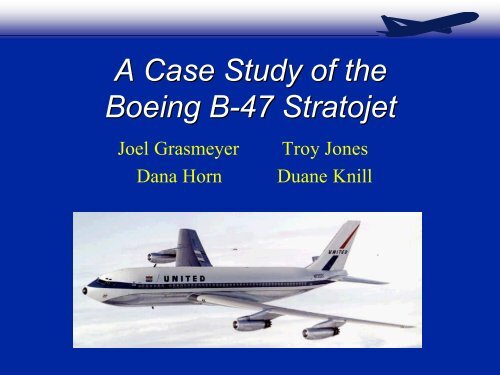A Case Study of the Boeing B-47 Stratojet - the AOE home page
A Case Study of the Boeing B-47 Stratojet - the AOE home page
A Case Study of the Boeing B-47 Stratojet - the AOE home page
You also want an ePaper? Increase the reach of your titles
YUMPU automatically turns print PDFs into web optimized ePapers that Google loves.
A <strong>Case</strong> <strong>Study</strong> <strong>of</strong> <strong>the</strong><br />
<strong>Boeing</strong> B-<strong>47</strong> B<br />
<strong>Stratojet</strong><br />
Joel Grasmeyer<br />
Dana Horn<br />
Troy Jones<br />
Duane Knill
Outline<br />
u The political and economic climate<br />
u The evolution <strong>of</strong> <strong>the</strong> B-<strong>47</strong><br />
u B-<strong>47</strong> innovations in aerodynamics, stability and<br />
control, and structures<br />
u The legacy <strong>of</strong> <strong>the</strong> B-<strong>47</strong>
At This Time in History ...<br />
u It’s 1943 and World War Two is raging<br />
u Aircraft production in <strong>the</strong> U.S. is staggering<br />
u Aircraft development is rapid<br />
– Piston engine technology reaching limits<br />
– Turbojet engines show promise<br />
– Britain and Germany have advantage<br />
– Reports <strong>of</strong> German fighter jets prompt U.S. to consider<br />
jet bombers
Origins <strong>of</strong> <strong>the</strong> B-<strong>47</strong>B<br />
u Air Corps Design Competition, 1944<br />
– Design high speed jet bomber, 500 mph +<br />
– 8,000 pound payload<br />
– Range <strong>of</strong> 2,500 to 3,500 miles<br />
– Service Ceiling <strong>of</strong> 40,000 feet<br />
u Designs submitted in 1944<br />
– North American B-45<br />
– Convair B-46<br />
– <strong>Boeing</strong> B-<strong>47</strong><br />
– Martin B-48
Evolution <strong>of</strong> <strong>the</strong> B-<strong>47</strong>B<br />
u B-<strong>47</strong> began as straight wing design<br />
– Limited top speed to under 500 mph<br />
u Operation Paperclip<br />
– Adolph Busemann<br />
– Swept wing <strong>the</strong>ory in 1935<br />
u Engines and more engines<br />
– Fuselage and wing mounted<br />
– Four or six?
Evolution <strong>of</strong> <strong>the</strong> B-<strong>47</strong>B<br />
Model # Date Wing Engines<br />
413<br />
422<br />
Jan. 1944<br />
early 1944<br />
Straight<br />
Straight<br />
4 Turbojets<br />
4 Turboprops<br />
424,425<br />
426<br />
early 1944<br />
early 1944<br />
Straight<br />
Straight<br />
4 Turbojets<br />
4 Turboprops<br />
432<br />
446<br />
Dec. 1944<br />
Sept. 1945<br />
Straight<br />
Swept<br />
4 Jets in Fuse.<br />
4 Jets in Fuse<br />
448<br />
448-2-2<br />
Sept. 1945<br />
Sept. 1945<br />
Swept<br />
Swept<br />
6 Jets in Fuse.<br />
6 Jets in Fuse.<br />
450 Oct. 1945 Swept 6 Jets under wings
Evolution <strong>of</strong> <strong>the</strong> B-<strong>47</strong>B<br />
Image from: The Politics <strong>of</strong> <strong>the</strong> U.S. Strategic Bomber Program<br />
Michael E. Brown, 1992.
The Production B-<strong>47</strong>B<br />
Images From: American Warplanes, Bill Gunston, 1986.
Podded Engines on <strong>the</strong> Wing<br />
Image From: American Warplanes, Bill Gunston, 1986.
Podded Engine Advantages<br />
u Interference drag was reduced in <strong>the</strong> wind tunnel<br />
u Strut weight was minimal<br />
u Increased span loading<br />
– Reduced <strong>the</strong> wing root bending moment<br />
– Reduced wing weight<br />
u Forward mass increases flutter resistance<br />
u Increased accessibility for maintenance<br />
u Increased passenger safety in case <strong>of</strong> an engine fire
Pitch-up Problems (Dana)
Longitudinal Stability (Dana)
The Yaw Damper (Dana)
The Flexible Wing<br />
u Long range transonic cruise requirements:<br />
– Large span for minimum induced drag (116 ft.)<br />
– Thin airfoils for minimum wave drag (12%)<br />
u This led to a very flexible wing<br />
u The load distribution was shifted inboard at high g’s<br />
– This allowed an 8 ft. span extension at each tip without<br />
changing <strong>the</strong> original wing structure or engine locations<br />
u Acted as a shock absorber to reduce gust loads
The Legacy <strong>of</strong> <strong>the</strong> B-<strong>47</strong>B<br />
u The B-<strong>47</strong> led directly to <strong>the</strong> development <strong>of</strong> <strong>the</strong> 707<br />
u Today’s commercial transports follow <strong>the</strong> design<br />
paradigm <strong>of</strong> <strong>the</strong> B-<strong>47</strong>/707<br />
<strong>Boeing</strong> 720<br />
1960<br />
<strong>Boeing</strong> 777<br />
1996
References<br />
u<br />
u<br />
u<br />
u<br />
Brown, Michael E., Flying Blind - The Politics <strong>of</strong> <strong>the</strong> U.S.<br />
Strategic Bomber Program. Cornell University Press,<br />
London, 1992.<br />
Cook, William H., The Road to <strong>the</strong> 707, TYC Publishing,<br />
Bellevue, 1991.<br />
Donald, David, Ed. American Warplanes <strong>of</strong> World War II.<br />
Aerospace Publishing Limited, London 1995.<br />
Gunston, Bill, American Warplanes. Salamander Books,<br />
New York, 1986.<br />
u Irving, Clive, Wide-Body: The Triumph <strong>of</strong> <strong>the</strong> 7<strong>47</strong>,<br />
William Morrow, New York, 1993.

















